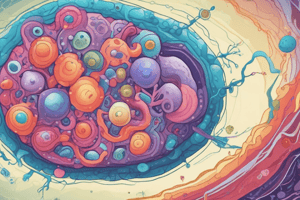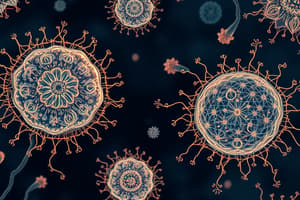Podcast
Questions and Answers
Which characteristic distinguishes Eukarya from Bacteria and Archaea?
Which characteristic distinguishes Eukarya from Bacteria and Archaea?
- Presence of a cell membrane.
- Presence of a nucleus and membrane-bound organelles. (correct)
- Presence of a DNA genome.
- Presence of ribosomes.
Why is the RNA gene commonly used to construct the phylogenetic tree of life?
Why is the RNA gene commonly used to construct the phylogenetic tree of life?
- It is found exclusively in eukaryotic organisms.
- It is only present in non-living infectious agents.
- It is composed of protein subunits.
- It is present in all living cells and has a conserved function. (correct)
How do prions cause neurological diseases in mammals?
How do prions cause neurological diseases in mammals?
- By being misfolded proteins that induce other proteins to misfold, leading to cellular damage. (correct)
- By directly competing with beneficial bacteria for resources in the nervous system.
- By disrupting the gut microbiome, leading to inflammation that affects the brain.
- By altering the composition of ribosomes, thus affecting protein synthesis in neurons.
In what way do resident microbes in the human body protect against pathogenic invasion?
In what way do resident microbes in the human body protect against pathogenic invasion?
Which of the following comparisons regarding ribosome size is correct?
Which of the following comparisons regarding ribosome size is correct?
How does microbial activity contribute to nutrient cycling in the environment?
How does microbial activity contribute to nutrient cycling in the environment?
A newly discovered microbe possesses a nucleus and is significantly larger than most known bacteria. To which domain does it likely belong?
A newly discovered microbe possesses a nucleus and is significantly larger than most known bacteria. To which domain does it likely belong?
If a scientist discovers a new species of bacteria, what is the correct way to denote it following binomial nomenclature?
If a scientist discovers a new species of bacteria, what is the correct way to denote it following binomial nomenclature?
Flashcards
Three Domains of Life?
Three Domains of Life?
Archaea, Bacteria, and Eukarya.
Prokaryotic Domains?
Prokaryotic Domains?
Archaea and Bacteria.
Ribosome Composition?
Ribosome Composition?
Protein subunits + ribonucleic acid (RNA).
Structures Common to All Cells?
Structures Common to All Cells?
Signup and view all the flashcards
Non-Living Infectious Agents?
Non-Living Infectious Agents?
Signup and view all the flashcards
Eukaryotic Microbes?
Eukaryotic Microbes?
Signup and view all the flashcards
Microbial Benefits?
Microbial Benefits?
Signup and view all the flashcards
Bacteriology Taxonomic Groupings?
Bacteriology Taxonomic Groupings?
Signup and view all the flashcards
Study Notes
- The three domains of life are Archaea, Bacteria, and Eukarya.
- Archaea and Bacteria are prokaryotic domains.
- The ribosomal RNA gene from many living organisms is sequenced and compared to generate the phylogenetic tree of life.
- Ribosomes are composed of protein subunits and ribonucleic acid (RNA).
- DNA genome, ribosomes, membrane, and cytoplasm are common to all living cells.
- Prions and viruses are two types of non-living infectious agents
- Prions are acellular and consist only of protein, and affect mammals, causing neurological diseases like mad cow disease.
- Viruses are acellular, consist of nucleic acid (DNA or RNA) and protein, lack a cell membrane, and depend on a host cell for reproduction.
- Algae, protists, protozoa, and fungi are eukaryotic microorganisms.
Comparing Prokaryotes and Eukaryotes
| Characteristic | Prokaryote | Eukaryote |
|---|---|---|
| Nucleus & Organelles | No | Yes |
| Cell Size | Smaller | Larger |
| Ribosome Size | 70s (smaller/lighter) | 80s (larger/heavier) |
Benefits of Microbes
- Aid in the development of intestines.
- Good bacteria takes up space, preventing pathogens from competing for limited resources.
- Reduce inflammation.
- Produce short chain fatty acids.
- Enable oxygen maintenance/production.
- Involved in nutrient cycling/decomposition.
- Cellulose breakdown in plants.
- Play a role in bioremediation/waste treatment.
Location of Microbes in the Human Body
- Skin and its contiguous mucous membranes (respiratory tract, GI tract).
- Upper respiratory tract (oral cavity, pharynx, nasal).
- GI tract (mouth, rectum, anus).
- Outer opening of urethra.
- External genitalia (vagina).
- External ear canal.
- External eye (lids, lashes).
- Most microbes are beneficial.
Microbes in the Environment
- Microbes are ubiquitous.
Taxonomic Groupings in Bacteriology
- Genus, species, and strain (subspecies) are primarily used taxonomic groupings.
- Genus is always capitalized.
- Species are always lower case.
- Genus species are italicized or underlined, also known as G. species.
Studying That Suits You
Use AI to generate personalized quizzes and flashcards to suit your learning preferences.
Description
Explore the three domains of life: Archaea, Bacteria, and Eukarya, with a focus on the characteristics that differentiate prokaryotes and eukaryotes. Discover the impact of prions and viruses as non-living infectious agents, and learn about eukaryotic microorganisms: algae, protists, protozoa, and fungi. Dive into cell structures such as ribosomes, DNA, and membranes.




